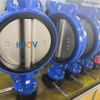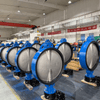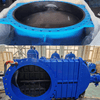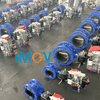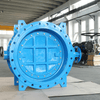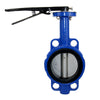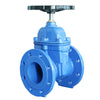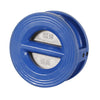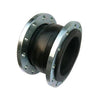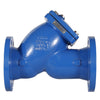Gate Valve Types and Selection: A Detailed Guide
What Is a Gate Valve and How It Works
A gate valve is a type of valve designed primarily for on–off control of fluid flow. It features a full-bore flow passage, which allows the medium to pass through with minimal resistance when the valve is fully open, ensuring efficient flow throughout the system.
Unlike globe valves or butterfly valves, a gate valve is not suitable for throttling applications. When it operates near the closed position, the fluid velocity rises sharply, which can cause erosion and wear on the gate and seat surfaces, eventually leading to sealing failure or leakage.
In water supply, wastewater treatment, and industrial fluid systems, gate valves are commonly used for shut-off and isolation purposes, ensuring that the pipeline can be safely closed during maintenance or inspection.

Main Types of Gate Valves
By Gate Disc Type
1.Solid Wedge Gate Valve
This is the most common design. The solid wedge offers a robust structure and simple manufacturing process, making it suitable for most temperature and pressure conditions. However, if the pipeline experiences slight deformation or thermal expansion, the sealing surfaces may become slightly misaligned.
Typical applications: municipal water supply, HVAC systems, and general industrial pipelines.

2.Flexible Wedge Gate Valve
The gate features a circumferential groove, giving it a certain degree of flexibility. This allows it to automatically adjust to thermal expansion and minor seat misalignment, ensuring a more reliable seal under fluctuating conditions.
Typical applications: steam, hot water, and high-temperature oil systems.

3.Parallel Gate Valve
This design uses two parallel gate plates that are pressed against the seat by a spring or the fluid pressure itself. It has a compact structure, smooth operation, and low friction resistance, making it efficient and easy to operate.
Typical applications: low-pressure water systems and large-diameter distribution networks.

The gate is a thin, sharp-edged plate designed to cut through fluids containing solids, fibers, or slurries, preventing clogging and providing a self-cleaning effect during operation.
Typical applications: wastewater treatment, paper and pulp production, mining, and chemical processing systems where the medium contains impurities or suspended solids.
By Stem Structure
In this design, the stem moves up and down together with the gate, and the stem threads are positioned outside the bonnet. This allows operators to clearly see the valve’s open or closed position, making it easy to operate and maintain. However, it requires more installation space due to the upward movement of the stem.
Typical applications: above-ground installations, water treatment plants, fire protection systems, and industrial equipment.
Here, the stem rotates in place without vertical movement, while the gate moves up and down inside the valve body. This compact structure saves space and is ideal for underground or confined-space installations.
Typical applications: underground water pipelines, valve chambers, and municipal water distribution networks.

By Sealing Type
1.Resilient Seated Gate Valve
The gate surface is coated or fully encapsulated with rubber, commonly EPDM or NBR, which enables zero-leakage sealing even under low pressure. It provides excellent corrosion resistance and requires minimal maintenance, making it the preferred choice in modern water supply systems.
Typical applications: drinking water, irrigation, and wastewater treatment systems.
This type adopts metal-to-metal sealing surfaces, allowing it to withstand high-temperature and high-pressure conditions. It requires high machining precision and is suitable for demanding service environments.
Typical applications: steam, oil, and industrial fluid systems.

Special Function: Gate Valve with Bypass Valve
In certain high-pressure, large-diameter, or special operating conditions, a standard gate valve can experience a high starting torque during initial opening due to a significant pressure difference between the upstream and downstream sides. This not only makes operation difficult but may also damage the sealing surfaces.
To address this, a bypass line equipped with a small auxiliary valve (bypass valve) is installed between the two sides of the main valve. The bypass valve assists in pressure equalization and improves operating conditions for the main valve.
Working principle: Before opening the main gate valve, the bypass valve is first opened to allow a small amount of fluid to flow through. This equalizes the pressure on both sides of the main valve, thereby reducing the opening torque, preventing water hammer, and ensuring smooth and safe operation.
When to Use a Gate Valve with a Bypass Valve
- High pressure differential: Helps balance pressure on both sides of the valve, reducing opening torque and ensuring easier operation.
- Media prone to solidification: Maintains a small continuous flow through the bypass when the main valve is closed, preventing solidification or blockage.
- Long pipeline systems: Allows gradual filling of pipelines during startup, avoiding water hammer and enabling a smooth system start.
- High-temperature systems: Used for preheating downstream pipelines to ensure even temperature rise and eliminate thermal stress.

Main Components of a Gate Valve
A gate valve is primarily composed of three key parts: the valve body, bonnet, and internal components.
These elements work together to ensure reliable sealing, structural strength, and smooth operation under varying pressure and temperature conditions.

1.Valve Body
The valve body serves as the pressure-containing shell of the gate valve. It houses all internal components and connects the valve to the pipeline, ensuring structural integrity and safe operation under varying pressure and temperature conditions.
Common connection methods include the following:
-
Flanged Connection
This is the most widely used connection type in industrial and municipal water systems. It provides strong structural stability and is easy to assemble and disassemble, making it ideal for pipelines that require regular inspection or maintenance. The flanged joint ensures good alignment during installation and reliable sealing performance. -
Threaded Connection
Typically applied in small-diameter, low-pressure, or non-critical piping systems, threaded connections allow quick installation without welding. While convenient, they offer relatively limited sealing performance and are best suited for domestic water systems or localized control points. -
Socket Weld Connection
In this type, the valve body is inserted into the pipe and welded, forming a compact, leak-free joint without threaded interfaces. It is suitable for medium- to high-pressure systems or applications requiring high sealing integrity. -
Butt Weld Connection
This method provides a strong welded joint with minimal flow resistance, ideal for high-temperature, high-pressure, or continuous operation pipelines. Once installed, it is nearly non-detachable, offering a permanent and highly reliable connection.

2.Bonnet
The bonnet seals the upper part of the valve body, enclosing the stem and operating mechanism. It is removable for inspection and maintenance, and its structural form varies according to the system’s pressure and temperature requirements.
Common bonnet types include:
-
Bolted Bonnet
This is the most common design, where the bonnet is tightly fastened to the valve body with bolts and nuts. It offers reliable sealing, easy assembly and disassembly, and convenient maintenance. This type is suitable for most standard pressure and temperature conditions. -
Welded Bonnet
In this design, the bonnet is fully welded to the valve body, providing excellent sealing performance and the ability to withstand high temperature and high pressure. It is typically used in steam, oil, gas, and high-pressure water systems. -
Threaded Bonnet
A compact and economical structure, the threaded bonnet connects to the valve body through threads. It is mainly used for small-diameter, low-pressure valves or auxiliary pipelines, where maintenance is simple and space is limited.

-
Pressure-Seal Bonnet
This type relies on internal system pressure to achieve a self-sealing effect—the higher the pressure, the tighter the seal. It is particularly suitable for high-pressure steam and liquid transport systems, where reliability and sealing integrity are critical. -
Extended Bonnet
The stem passage is elongated to adapt to low-temperature, cryogenic, or buried pipeline applications. This design prevents stem frosting and allows easier operation in underground or insulated environments.

Extended stem gate valve
3.Internal Parts
-
Stem
The stem connects the handwheel or actuator to the gate, transmitting the opening and closing force. Depending on the valve design, it can be of the rising-stem or non-rising-stem type. -
Gate (Disc)
The gate, also known as the disc, is the core component controlling the flow of the medium. Its material and structural design directly determine the valve’s sealing performance and durability. -
Seat
The seat provides the sealing surface against which the gate closes. It may be integrally cast with the valve body or replaceable, installed by threading or pressing. Replaceable seats simplify maintenance and allow flexibility in selecting sealing materials for different media.
Actuation Methods of Gate Valves
-
Manual Operation (Handwheel)
The most common method, suitable for standard on/off control in pipelines. It offers simple operation and reliable performance for general service conditions. -
Electric Actuator
Used in remote control and automated systems, electric actuators provide precise positioning and convenient control. They are commonly applied in water treatment plants, industrial distribution networks, and large-scale installations. -
Pneumatic Actuator
Featuring fast response and high operating efficiency, pneumatic actuation is ideal for large-diameter valves or industrial process control systems where quick operation is required.
Common Design and Testing Standards
|
Category |
Standard No. |
Description |
|
Design & Manufacture |
API 600 / API 6D / ASME B16.34 |
Standards for design, construction, and pressure rating of gate valves. |
|
Flanged Ends |
ASME B16.5 / EN 1092-1 |
Defines flange dimensions, bolt hole patterns, and pressure classes. |
|
Butt Weld Ends |
ASME B16.25 |
Specifies dimensions and preparation for butt-welded connections. |
|
Socket Weld Ends |
ASME B16.11 |
Standard for socket-weld fittings and connection details. |
|
Threaded Ends |
ANSI B1.20.1 (BSP / NPT) |
Thread specification for threaded-end valves. |
|
Face-to-Face Dimensions |
ASME B16.10 |
Defines standard face-to-face and end-to-end dimensions for valves. |
|
Pressure Testing |
API 598 / EN 12266-1 |
Requirements for shell and seat leakage testing. |
|
Fire-Safe Design |
API 607 / API 6FA / EN ISO 10497 |
Fire-safe performance and testing standards for valves. |
Gate Valve Selection Guide
|
Service Condition |
Recommended Type |
Key Features |
|
Municipal Water Supply / Potable Water |
Resilient Seated Gate Valve |
Corrosion-resistant, zero leakage, easy maintenance. |
|
Wastewater / Media Containing Solids |
Parallel Gate Valve |
Smooth operation, less prone to clogging, reliable shut-off. |
|
Steam / Hot Water Systems |
Flexible Wedge Gate Valve |
Adapts to temperature variation, stable sealing performance. |
|
High Temperature & High Pressure Systems |
Metal Seated Gate Valve |
Excellent wear and pressure resistance, robust construction. |
|
Underground Installation |
Non-Rising Stem Gate Valve |
Space-saving design, reliable sealing in buried conditions. |
|
Industrial Automation Systems |
Electric / Pneumatic Gate Valve |
Easy operation, suitable for remote and automated control. |
Conclusion
With their low flow resistance, reliable sealing, and simple structure, gate valves are widely used in water supply, wastewater, and various industrial systems as essential shut-off devices within pipelines.
Understanding the differences in gate disc designs, sealing types, and actuation methods helps buyers select the most suitable valve for their specific working conditions—enhancing system reliability, safety, and operational efficiency.
At Union Valve, we are dedicated to providing high-quality gate valve solutions and technical support for diverse industries. Whether for municipal water supply, wastewater treatment, or industrial applications, we have earned the trust of our clients through consistent quality and professional service.
Contact our technical team today for expert valve selection advice and customized solutions tailored to your system requirements.
Related Articles:
- How to Choose Between Flanged and Socket Weld Gate Valves for Industrial Pipelines
- Gate and Check Valves: Clear Comparison Guide
- Why Gate Valves Leak and How to Fix It
- What Is The Difference Between Wedge-Type Gate Valve And Slab Gate Valve?
- Characteristics of Resilient Seated Gate Valve and Their Differences from Metal Sealing Gate Valves
